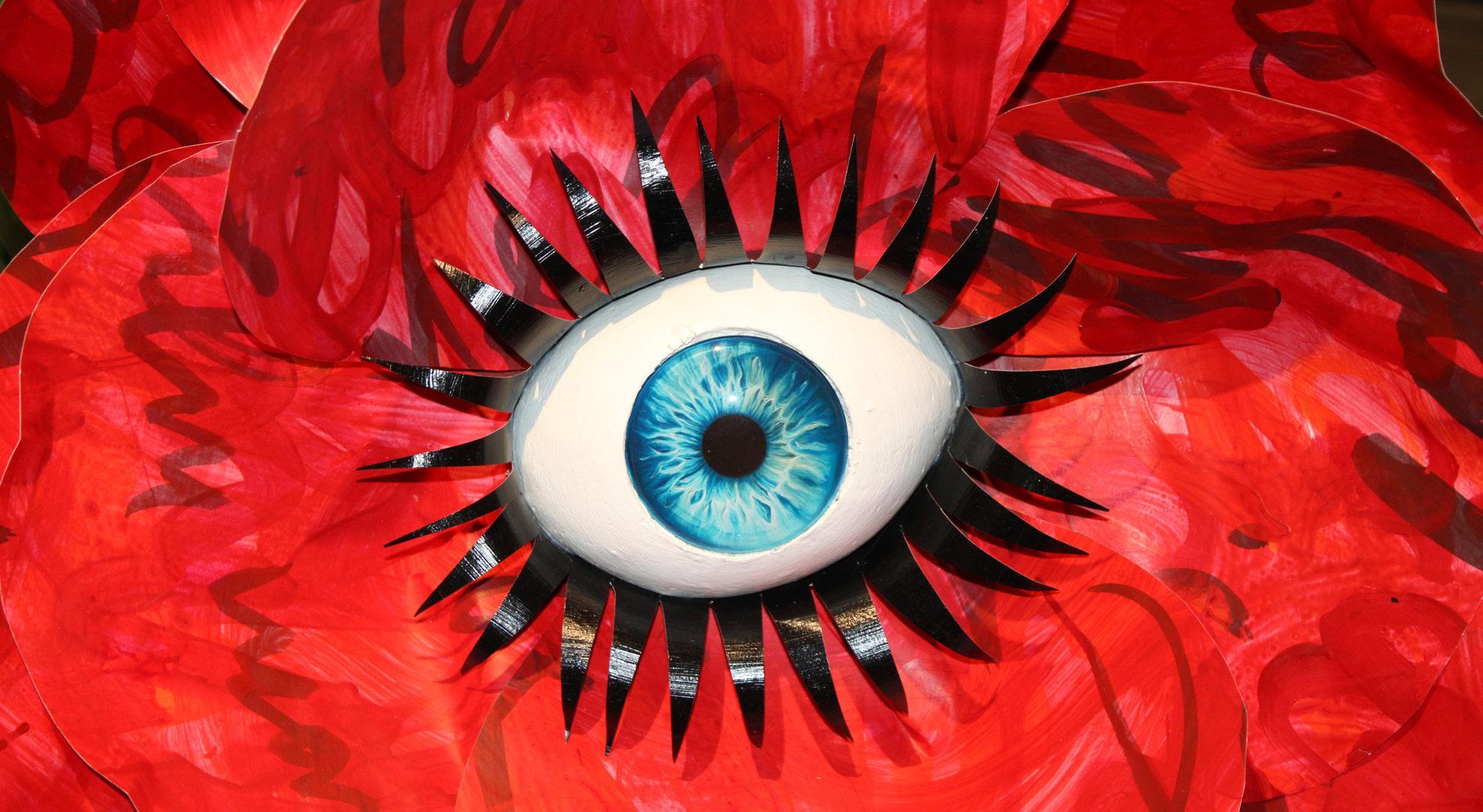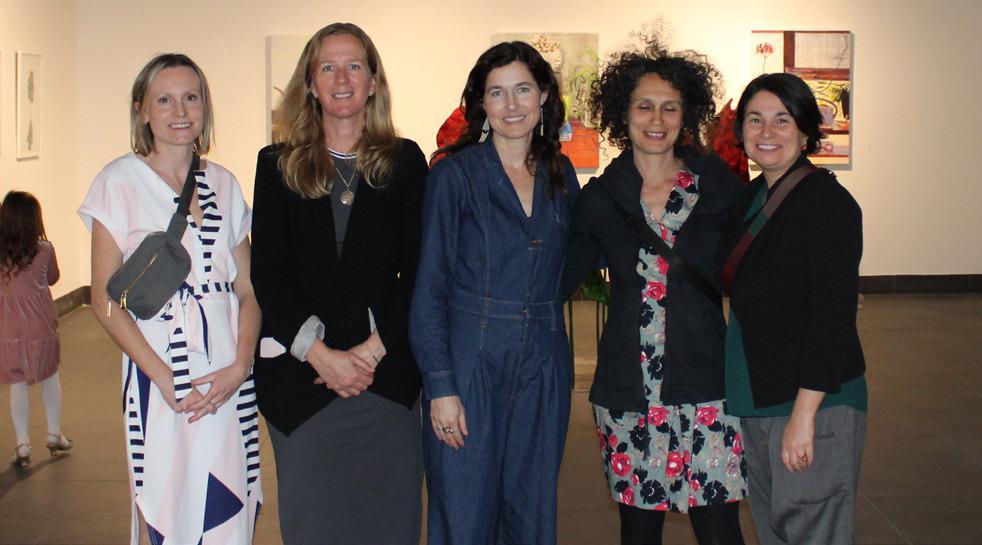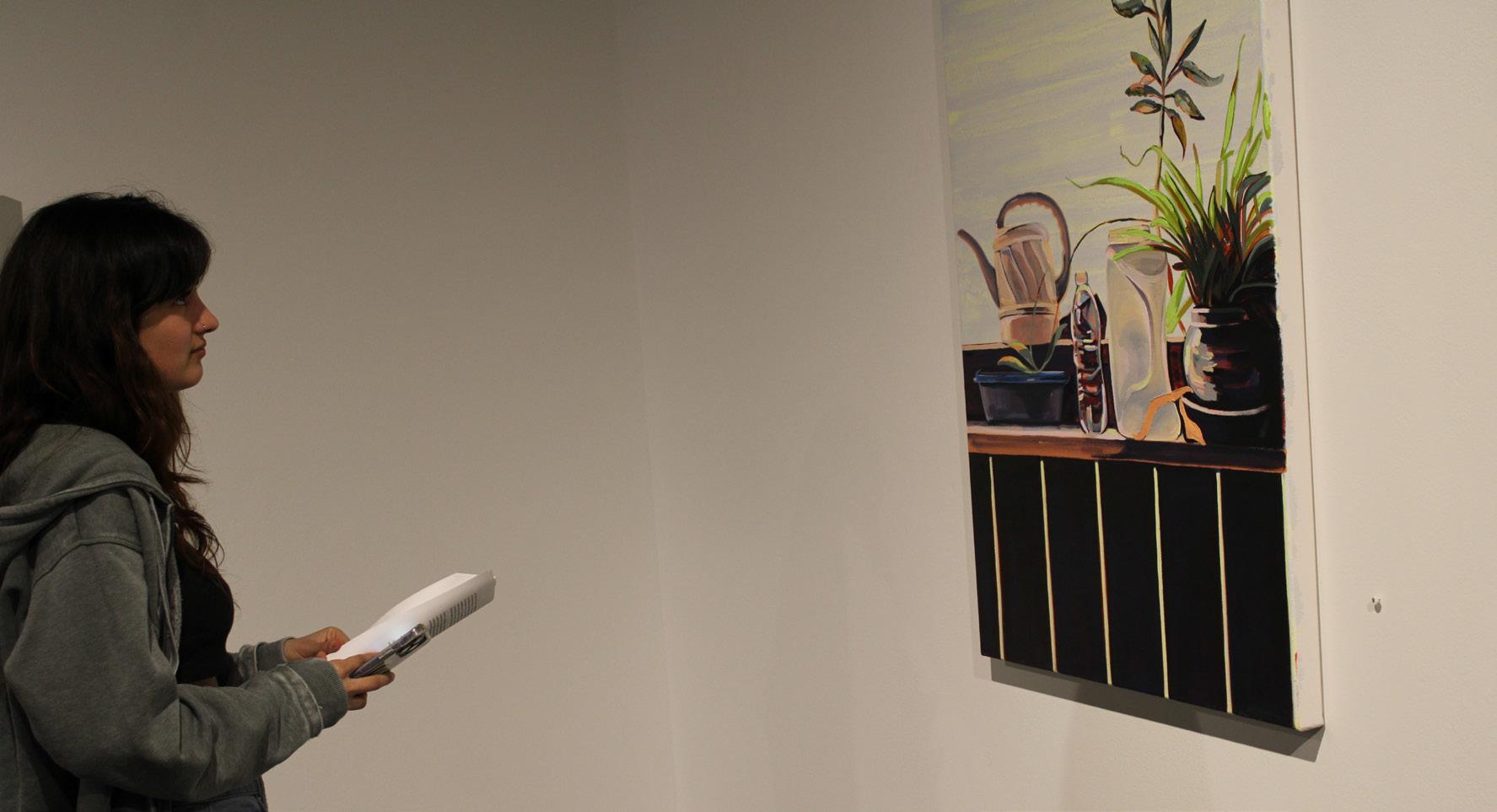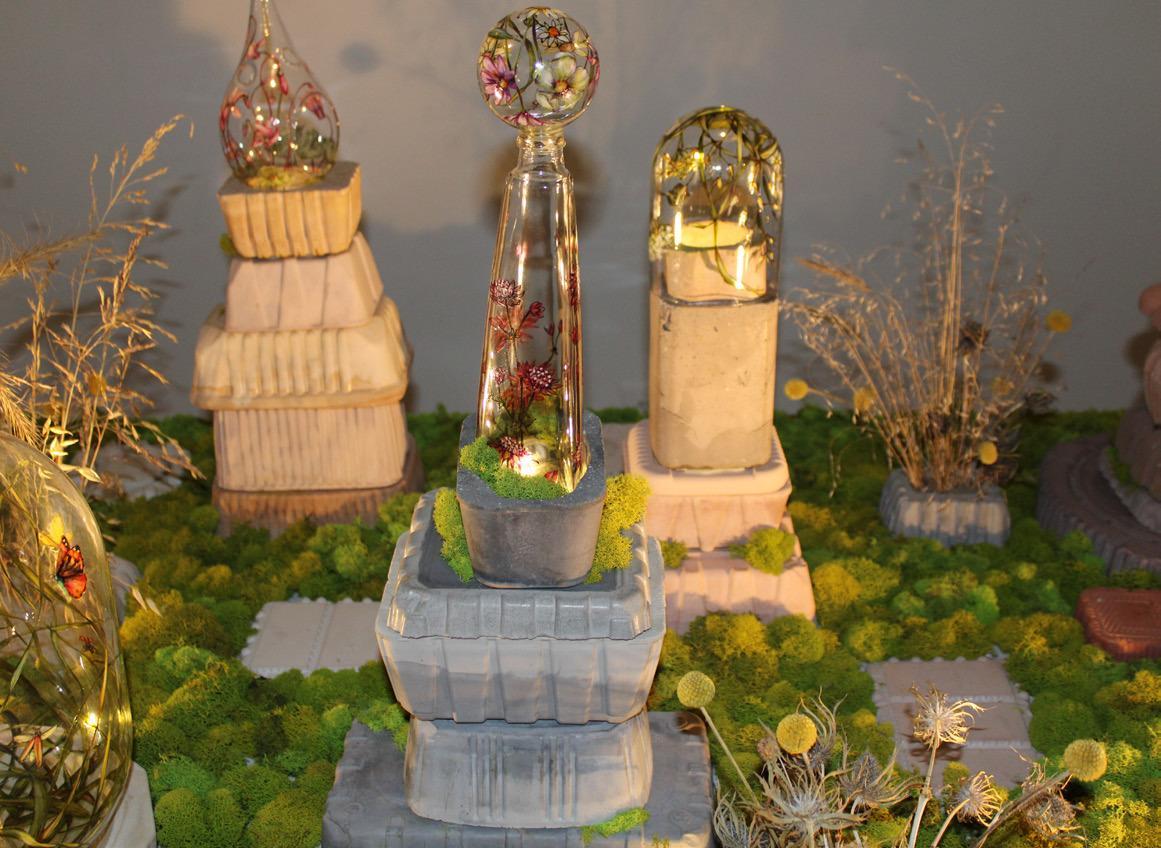

Top, a close up look at Witnesses, a piece of art by Yulia Lanina at the Nature Nurture/Nurture Nature art exhibit. Above, the exhibit has artwork by Lana Waldrep Appl — TXST studio art lecturer, Elizabeth Chiles — University of Texas Art History lecturer, Sarah Hirneisen — TXST School of Art and Design Lecturer, Yuliya Lanina — University of Texas Arts and Entertainment Technologies Assistant Professor of Practice, and Yevgenia Davidoff — an Austin based artist and designer.
Daily Record photos by Shannon West

Some of this year’s winners of the Love Downtown Awards.
Photo provided by San Marcos Downtown Manager Josie Falletta.

Photo provided by Downtown Manager Josie Falletta.
Nature/Nurture Exhibit at TXST until March 31
The divine mother, or mother nature herself, is vast and overarching; she evokes deep emotions with her various colors and forms. For seemingly all of existence, human beings have been endlessly fascinated by her. A trip into the Texas State University FLEX Gallery will transport you into a serene botanical wonderland rich with luscious flowers, moss, tree fungus and other natural elements.
The Nature Nurture/ Nurture Nature exhibit has artwork by Elizabeth Chiles — University of Texas Department of Art and Art History lecturer, Yevgenia Davidoff — an Austin based artist and designer, Sarah Hirneisen — Texas State University School of Art and Design lecturer, Yuliya Lanina — University of Texas Department of Arts and Entertainment Technologies assistant professor of practice, and Lana Waldrep Appl — Texas State University studio art lecturer. Though each artist has a distinct point of view, the pieces form a cohesive and thought provoking exhibit that is a must see.
Davidoff’s piece Cathedrals of the Future, is a 75-by-40-inch city-scape installation in which the buildings are made of concrete and glass flasks with hand painted flowers that each contain their own light source. There is moss and other dried plants, which seamlessly connect the man-made to the natural elements. The shadows cast on the walls feel like spirits haunting the space above the piece. Davidoff used various containers and cast them in concrete. She said she would take the containers and glass flasks and rearrange them during what she called a “meditative process” — stacking, unstacking, trying different combinations and stacking again. Through this process she found that each piece had its own distinct architectural language. She began to research Rudolf Steiner who saw the architectural space as a conduit for spiritual assent, which informed the direction of the installation.
“By utilizing certain shapes, materials, lights [and] where it’s situated in the landscape, it really could create an almost religious experience for you,” Davidoff said. “So I wanted to conflate in that installation the metaphysical, the spiritual and yet our man made world, and see how we can reconcile it maybe through these magnified, overlapped realities through light and shadow.”
Davidoff said the installation is a tribute to her mother, who had asked her to paint a field of wildflowers before her passing.
“Those meditations, those rituals that I started doing, it was a way for me to process grief,” Davidoff said. “I had this unfulfilled wish that was looming over me, and I thought, how do I fulfill it? So every single item that I paint [flowers on], in my head, adds up to the field of wildflowers. So seeing this installation I feel very satisfied that I’m getting close to that wish.”
Immediately upon entering the exhibit, it’s hard to shake the feeling of being watched. And as you move through the room, your eyes are met with the attention- grabbing gaze of a large bouquet of Poppies. Lanina’s sculptural piece — Witnesses — had large red Poppies, each with an eye in the center, that were pointing in every direction. The sculpture was made with paper, acrylic, metal, polymer and glass.
“They symbolize witnessing and being witnessed at the same time. That show [during her Artpace residency] was about the war, because I’m from Russia and Ukraine. The Poppies are very common in that part of the world,” Lanina said. “Battlefields are a very fertile ground for poppies.”
Lanina had six pieces with acrylic and collage on paper also featured in the exhibit — Happy Couple, Home, Blossom Gaze, Anxious Thoughts, Walking into Oblivion and Future Looks Uncertain. Lanina said Anxious Thoughts, much like the name infers, is an expression of anxiety. It features a female body with a tight leather corset constraining the torso, and in lieu of a head is many eyes. It accurately captures the tight-chest feeling and overanalyzing that anxiety entails.
“That piece became the beginning of a whole project that I did,” Lanina said. “A lot of eyes came from that and even the flowers in some ways.”
Hirneisen’s piece Circuition captures the cycle of life by using a cast of a tree trunk on the floor with various strings coming off of it that are connected to casts of Shelf Fungus on the wall in various colors. She said she placed the colors from dark to light going up the wall to represent the new elements rising from the deteriorating ones. In last year’s ice storm, she lost a lot of trees in her yard. She started making molds of the trees as they were falling down and rotting.
“One of these trees had all of this Shelf Fungus on it,” Hirneisen said. “And then I was casting it and just really enjoyed the way it looked. … Shelf Fungus is interesting, because what I learned is it really only will grow on something that is about to die or is already dead. It creates this whole new habitat. [I was] thinking about life cycles as well, just this idea of things growing and then dying and then starting fresh. … Now looking at it, especially with the lighting, it makes me feel very peaceful.”
Hirneisen’s piece Assemblage is made from cast stones with delicate crocheted elements that are seemingly growing from the rocks similar to moss or lichen, which present a visually pleasing contrast between the hard and soft elements as seen in nature.
“I started thinking about the way that fungus grows on trees, and the way lichen and moss grows on rock,” Hirneisen said. “Adding these kinds of elements that look like they could be lichen or something growing on it [is] referencing just again that process of nature and almost adding this protective layer to it.”
Waldrep-Appl had four oil paintings in the exhibit — Globular Mass, Whiled, Oyster Mushroom Arrangement and Mother of a Million. She said during the pandemic she was pregnant with twins, which was debilitating. This forced her to interact more with the environment inside of her home and kept her artistic practice indoors as well. Several years later, she feels that these pieces evoke a sense of longing.
“The days that I always spent going out into the world turned inward. So I began looking at these domestic found still lifes,” Waldrep-Appl said. “There’s also issues around thinking about the way we live with our things. Which things do we think are less precious? Which things are trash. Which things do we feel like we can’t really get rid of?”
Waldrep-Appl’s paintings give you a peek inside her everyday life. It also imparts that beauty can be found in the happenstance arrangements developed through interactions with items in the home. In one of the still life paintings, Waldrep-Appl included a plastic water bottle, a tea pot and some plants on a black tile countertop.
“I think it’s a really good symbol. I like to use it, because, to me, it’s one of those things that you end up getting the most ecoguilt about because it’s water in a single-use reusable plastic bottle … Then you have to pay off your guilt by keeping them forever and using them to water plants,” Waldrep-Appl said. “All of these things kind of find their way together in these arrangements. A lot of times my kids will put these things together, or they’ll just land together based upon use. And they look right, and it becomes a still life.”
Chiles pieces in the exhibit, Hold the Light (dance), Hold the Light (lattice) and Hold the Light (believe), are light boxes containing photographs of lake scenes with water and sunlight peeking through the leaves of trees. Chiles takes the photo with the light source directly in front of the camera so that the LED light can replicate sunlight, and she prints the photos on Epson Backlit Film so that the light is visible through the photograph. The light boxes immerse the viewer in the lake scene, bringing it to life. It’s as if one can feel the warmth of the sun and the cool, dewy breeze wafting across the water.
“This is a walk that I’ve done for years and [I] admired the foliage when it’s backlit by the sun,” Chiles said, adding that the pieces evoke in her a sense of peace, wonder and happiness.
According to a press release for the exhibit, Chile’s work “masterfully intertwines the tangible and the transcendent, inviting viewers to contemplate the interconnectedness between the natural world and the unseen dimensions it may unveil.”
The Flex Gallery, on the second floor of the Joann Cole Mitte building, located at 601 University Drive, is open 9 a.m. to 7 p.m. Monday to Friday and 12 p.m. to 5 p.m. on Saturday and Sunday. The exhibit is on display until March 31.











